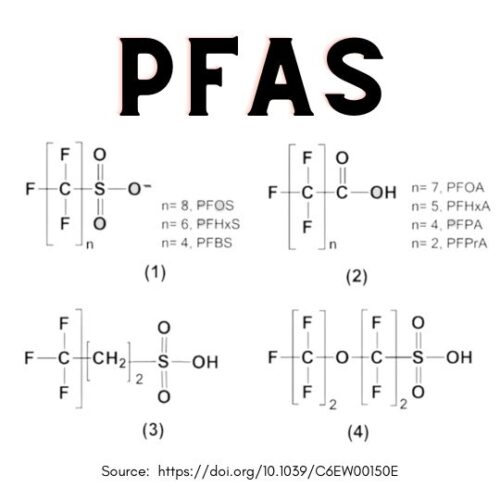The BBC reported on “Forever chemicals” found in make-up, citing brands such as Urban Decay and Revlon. Here is a link to that article
What is a “Forever Chemical?”
According to the UK government:
Poly- and perfluoroalkyl substances (PFAS) are a large group of synthetic organofluorine chemicals that have been widely used since the 1940s. By definition, all PFAS have at least one fully fluorinated methyl (–CF3) or methylene (–CF2–) group. The carbon-fluorine bond (C–F) is very strong. Consequently PFAS can resist chemical attack and withstand high temperatures and are sometimes referred to as ‘forever chemicals
See sources and uses below
What are Perfluoroalkyl Substances (PFAS)?
What is the concern about PFAs?
PFAs are increasingly detected as environmental pollutants and some are linked to negative effects on human health. They all contain carbon-fluorine bonds, which are one of the strongest chemical bonds in organic chemistry. This means that they resist degradation when used and also in the environment. Most PFASs are also easily transported in the environment covering long distances away from the source of their release. PFASs have been frequently observed to contaminate groundwater, surface water and soil. Cleaning up polluted sites is technically difficult and costly. If releases continue, they will continue to accumulate in the environment, drinking water and food.
European Chemicals Agency
Are they toxic?
These chemicals are so pervasive, that even if they were banned tomorrow, they would still linger in our environment. In studies involving animals, they have been found to be carcinogenic (cause cancer) and are also hormonal disruptors. Such chemicals are used in low-doses in (e.g.) personal care products, including cosmetics and quite frankly, there is not enough data linking PFAs to serious harm in humans. BUT that doesn’t mean their shouldn’t be restrictions on their use.
According to the EU
Certain PFASs are known to accumulate in people, animals and plants and cause toxic effects. Certain PFASs are toxic for reproduction and can harm the development of foetuses. Several PFASs may cause cancer in humans. Some PFASs are also suspected of interfering with the human endocrine (hormonal) system.
PFASs are released into the environment from direct and indirect sources, for example, from professional and industrial facilities using PFASs, during use of consumer products (e.g. cosmetics, ski waxes, clothing) and from food contact materials. Humans can be exposed to them every day at home, in their workplace and through the environment, for example, from the food they eat and drinking water.
European Chemicals Agency
What is next for PFAs?
Five European countries (Denmark, Germany, the Netherlands, Norway and Sweden) are proposing that the EU introduce regulations that restrict the use of PFAs in the EU. This kicks into action a series of data collection and review activities that WILL cause the EU to do “something” about these chemicals. (“something” could mean a ban or a restriction….
Sources and uses
Poly- and perfluoroalkyl substances (PFAS): sources, pathways and environmental data Chief Scientist’s Group report (UK government publication)
Our Current Understanding of the Human Health and Environmental Risks of PFAS
